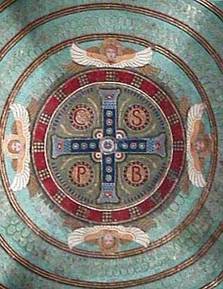In sixth-century Palestinian churches, the clergy sometimes placed a reliquary—a stone box for holy objects—beneath the altar. The reliquary looked like a small sarcophagus (stone coffin) with two to four compartments. The reliquary housed bits of martyrs’ bones, sometimes encased in smaller, precious-metal boxes. The center of the lid contained a funnel-shaped hole, with another one in the reliquary’s side. A goblet stood beneath the side hole. Worshipers poured oil into the top hole and recaptured it in the goblet. They considered the oil sanctified because it touched the sacred relics, and hoped the freshly produced “holy oil” would protect them as they ventured back into everyday life.
Although this Palestinian ritual may seem strange today, it capsulated a predominant Byzantine belief. Eastern Christians especially honored saints and martyrs, and considered their bones and artifacts sacred. They believed touching or owning a relic—the remains of something or someone sacred—transmitted healing and holiness. Ancient Christians traveled far to visit relics safeguarded in beautiful reliquaries, and churches collected these sacred remains as signs of protection and prestige.
As trade increased, more people traveled and Christianity proliferated, Eastern art and practices influenced Western Christians. Byzantine artists especially mastered painting icons, carving ivory, shaping metal, and designing mosaics. When artists passed along information about style and technique, tourists and merchants carried back works of art, or warriors carted home war booty, East and West shared their creativity. Artisans and craftspeople experimented, improved existing techniques, and introduced new stylistic approaches. Even when the Church split over theological differences, declaring distinct and bitter differences between the East and West, the artistic influences lingered and mingled.
For some projects the crossover was deliberate and planned. In the eleventh century Abbott Desiderius organized the decoration for the new abbey church of Montecassino in southern Italy. Sometime after 1066 he sent envoys to Constantinople “to hire artists who were experts in the art of laying mosaics and pavements.” The monk Leo of Ostia recorded, “The degree of perfection which was attained in these arts by the masters Desiderius had hired can be seen in their works.” Desiderius also arranged for the Byzantine master artists to teach his young Italian monks the art of mosaics. Italian artists revived the ancient art practiced by their ancestors.
Eventually, an appreciation for Eastern art spread. The abbott’s decisions blessed the world with beauty.
Read more about Byzantine artists in The Art of Faith: A Guide to Understanding Christian Images by Judith Couchman. Available at amazon.com and paracletepress.com.

 RSS Feed
RSS Feed



